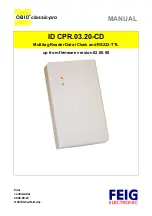
SLOU186F
–
AUGUST 2006
–
REVISED AUGUST 2010
5.2.4
Direct Mode
Direct mode allows the user to configure the reader in one of two ways. Direct mode 0 (bit 6 = 0, as
defined in ISO control register) allows the user to use only the front-end functions of the reader, bypassing
the protocol implementation in the reader. For transmit functions, the user has direct access to the
transmit modulator through the MOD pin (pin 14). On the receive side, the user has direct access to the
sub-carrier signal (digitized RF envelope signal) on I/O_6 (pin 23).
Direct mode1 (bit 6 = 1, as defined in ISO control register) uses the sub-carrier signal decoder of the
selected protocol (as defined in ISO control register). This means that the receive output is not the
sub-carrier signal but the decoded serial bit stream and bit clock signals. The serial data is available on
I/O_6 (pin 23) and the bit clock is available on I/O_5 (pin 22). The transmit side is identical; the user has
direct control over the RF modulation through the MOD input. This mode is provided so that the user can
implement a protocol that has the same bit coding as one of the protocols implemented in the reader, but
needs a different framing format.
To select direct mode, the user must first choose which direct mode to enter by writing B6 in the ISO
control register. This bit determines if the receive output is the direct sub-carrier signal (B6 = 0) or the
serial data of the selected decoder. If B6 = 1, then the user must also define which protocol should be
used for bit decoding by writing the appropriate setting in the ISO control register.
The reader actually enters the direct mode when B6 (direct) is set to 1 in the chip status control register.
Direct mode starts immediately. The write command should not be terminated with a stop condition (see
communication protocol), because the stop condition terminates the direct mode and clears B6. This is
necessary as the direct mode uses one or two I/O pins (I/O_6, I/O_5). Normal parallel communication is
not possible in direct mode. Sending a stop condition terminates direct mode.
shows the different configurations available in direct mode.
•
In mode 0, the reader is used as an AFE only, and protocol handling is bypassed.
•
In mode 1, framing is not done, but SOF and EOF are present. This allows for a user-selectable
framing level based on an existing ISO standard.
•
In mode 2, data is ISO-standard formatted. SOF, EOF, and error checking are removed, so the
microprocessor receives only bytes of raw data via a 12-byte FIFO.
22
System Description
Copyright
©
2006
–
2010, Texas Instruments Incorporated
focus.ti.com:
















































